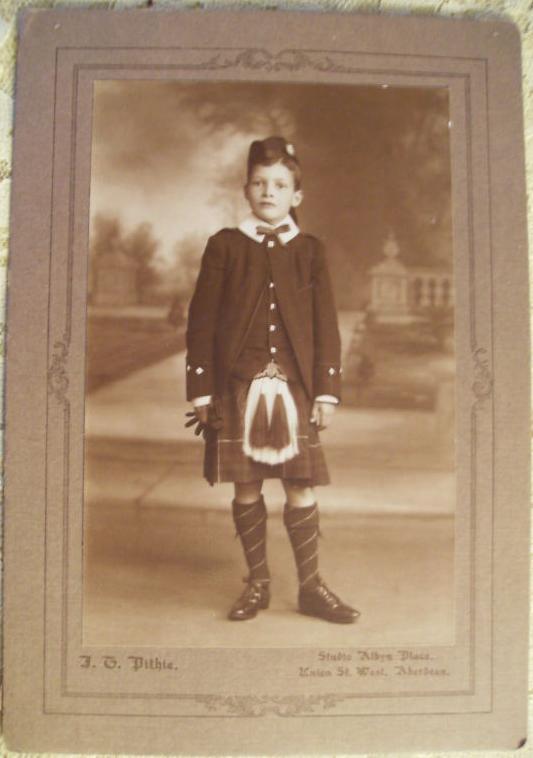
Figure 1.--This 1914 cabinet card shows Scottish boy France James Blake wearing a Highland kilt outfit. Note the destinctive cabinet card style. The photographer is Pithie in Aberdeen. |

|
Scotland was not involved in the early research on photography. After the announcements by Daguerre in France
and Talbot in England (1839), Scotts immediately began to take an interest. James Howie held a daguerreotype exhibition on Princes Street (1839). Pioneering work was done by Hill and Adamson (early-1840s). David Octavius was a painter working on a large commemorative work on the people involved in forming the Free Church of Scotland (1843). He used photography to help capture images of the church elders that he could then paint. .Shortly after the dawn of photography, the unlikely partnership between the respected painter Hill worked with a young engineer, Robert Adamson and together they produced some of the earliest photographic images of Scotland. They concentrated on the calotype process and produced several thousand imahes at their studio at Rock House, As in England, Daugerreotypes are relatively rate, but in the 1860s we begin to see large numbers of CDVs. A rare early female photographer was Julia Margaret Cameron (1815�79). Her photiography began in middle age when her daughter gave her a camera. She photographed celebrities as well as producing experimental images with Arthurian and other legendary themes.
Scotland was not involved in the early research on photography. After the announcements by Daguerre in France
and Talbot in England (1839), Scotts immediately began to take an interest. James Howie held a daguerreotype exhibition on Princes Street (1839). Pioneering work was done by Hill and Adamson (early-1840s). David Octavius was a painter working on a large commemorative work on the people involved in forming the Free Church of Scotland (1843). He used photography to help capture images of the church elders that he could then paint. .Shortly after the dawn of photography, the unlikely partnership between the respected painter Hill worked with a young engineer, Robert Adamson and together they produced some of the earliest photographic images of Scotland. They concentrated on the calotype process and produced several thousand images at their studio at Rock House. A rare early female photographer was Julia Margaret Cameron (1815-79). Her photography began in middle age when her daughter gave her a camera. She photographed celebrities as well as producing experimental images with Arthurian and other legendary themes. Another imprtant early Scottish photographer is Thomas Annan (1829-75). He left fascinating portraits and architecual images, but more importantly he documented the poor living conditions in Glasgow which included images of the children living there. An America folklorist and photograoher, Margaret Fay Shaw, has left us many charming images of life on the Heberdies, islands off the west coast of Scotland.
Daugerreotypes in Scotland, as in England. are relatively rate. In fact as Scotland had a much smaller population than England and was not as affluent. And affluence is a factor in demand for photography. Scottish Dags and other early formats are even more rare than in England. We believe that copyright laws in Britain and other Europeans countries restricted the growth of a photographic industry at a time it was booming in America. This changed dramatically with the appearance of CDVs. We begin to see large numbers of CDVs (1860s). Soon after we see the larger cabinet cards. We assume that the dates and the mounts are basically the same as in England, but there may have been some differences. Our assessment is limited by the fact tht we have so few dated Scottish photographs. Thus we are only beginning our assssment of Scottish photography. And like England, the CDV persisted much longer in Scotland than was the case of the United States. We see new cabinet card styles around the turn of the 20th century, but do not yet have the precise dates.
We have a lot of questions about Scottish photographic studios, actually European photogrraphic studios in general. Studios established in the 1840s were Daguerreotype studios. Those established in in the 1850s are more of a question. This is because there were many different formats offered in the 1850s, including Ambros, albumen (CDVs), Dags, tin-types, and others. We think that studios for the most part specialized in one format, but that needs to be confirmed. And as the CDV suddenly became the rage about 1859-60, we suspect that studios working with other formats either shifted to the CDV or went out of busuness. We are not sure how easy it was to convert and how successdfully Dag and Ambro photographers made that conversion. We note one studio established in 1853 (figure 1). But we do not know what format they offered at first. The CDV was patentented in France (1854). So we are left wondering if they begn doing CDVs before they were using the albumn process before the CDV was patented. We do know that they were doing CDVs in the 1860s. The situation was a little different in America. Despite having a much larger photographic industry than Europe, we do not see CDV studios until about 1859-60. By the mid-60s virtually all Scottish studios were albumen (CDV) studios. We have much more information about CDV studios than other formats, because studio information wa often printe on the front and back of the CDV. In the late-60s the cabint card appeared. The CDV continued to be the standard format in the 1870s. As the cabinet card also used the albumen process, no major conversion was required. But unlike America, it took some time for cabinet cards to become established.
Navigate the Boys' Historical Clothing Web Site:
[Return to:Main photography country page]
[Return to:Main photography page]
[Return to:Main Scottish page]
[Introduction]
[Activities]
[Biographies]
[Chronology]
[Clothing styles]
[Countries]
[Bibliographies]
[Contributions]
[FAQs]
[Glossaries]
[Images]
[Links]
[Registration]
[Tools]
[Boys' Clothing Home]
Navigate the Boys' Historical Clothing Web Site:
[Dresss]
[Sailor suits]
[Sailor hats]
[Buster Brown suits]
[Eton suits]
[Rompers]
[Tunics]
[Smocks]
[Pinafores]
